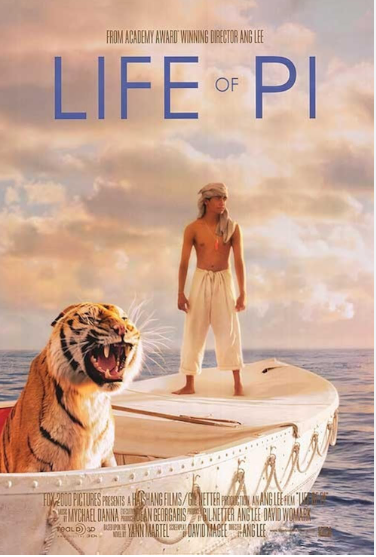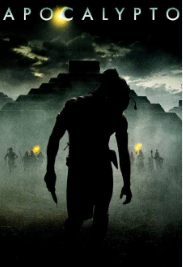1. Plot Summary
Pi Patel is an inquisitive teenager from Pondicherry, India, growing up in a family that runs a zoo. He is religiously curious, embracing Hinduism, Islam, and Christianity, even as his father tries to keep him grounded in practical, rational thinking.
When Pi’s family decides to emigrate to Canada, they set sail on a freighter with the zoo animals. A storm strikes, and the ship sinks. Pi survives, but finds himself stranded on a lifeboat in the Pacific Ocean—alone except for a Bengal tiger named Richard Parker and a few other animals (initially). Over 227 days, Pi grapples with nature, starvation, storms, hope, and fear, while forming an uneasy coexistence with Richard Parker. His journey becomes one of survival, faith, and identity.
The story is framed as an older Pi recounting his experiences to a writer, leaving open questions about what parts of his story are literal, symbolic, or perhaps invented.
2. Notable Elements
- Cinematography & Visuals: Claudio Miranda’s work is breathtaking—spectacular use of 3D, water, lighting, horizon, vast ocean expanses, the surreal tiger vs sea scenes. The film won an Oscar for Best Cinematography.
- Visual Effects & Set Pieces: Many scenes are visually stunning — bioluminescent sea, the storm, the carnivorous floating island, the scenes with flying fish. These are not just decorative but serve to reflect Pi’s emotional or spiritual states.
- Acting / Character Work: Suraj Sharma (young Pi) delivers a strong performance, especially considering much of his “co-stars” are CGI animals or green screen. Irrfan Khan as older Pi gives the story its reflective weight.
- Narrative Framing & Symbolism: The movie doesn’t shy away from asking big questions: faith vs reason; what kind of story we choose to believe; how suffering shapes belief. The framing device with the adult Pi and the writer invites the audience to question reality vs meaning.
3. Themes & Messages
- Faith, Belief & Storytelling: One of the central themes is how faith and belief help humans endure hardship. Pi’s multi-religious beliefs are not portrayed dogmatically but as part of his search for meaning. The film suggests that stories themselves are a kind of faith.
- Survival & Adaptation: Physical survival is obviously central, but equally important is psychological survival — adapting one’s beliefs, finding companionship (even in fear), coping with loss.
- Nature’s Beauty and Terror: The ocean is depicted as both beautiful and terrifying. The tiger is both adversary and lifeline. Nature is not simply a backdrop—it is an active force.
- Truth, Reality, Allegory: The alternate “more brutal” version of the tragedy (seen in the book and referenced in film) presses viewers to ask: what do we prefer — a harsher truth, or a story that gives hope? The film doesn’t enforce one answer; it leaves space for ambiguity.
4. Personal Impressions
What I Loved:
- The visual spectacle. Life of Pi is one of those rare films where the beauty of the images adds meaning, not just window dressing. The ocean, light, the interplay between sky and water, storms—these are unforgettable.
- The emotional and spiritual resonance. It’s not just “boy vs tiger” survival; it’s about loss, identity, faith, meaning. Even when things are harsh, there’s wonder.
- The balance between huge scale and intimate moments. Pi’s conversations with himself, his memories, his reflections—these quieter moments offset the spectacle nicely.
What Was Harder to Swallow:
- Some of the slower stretches can feel meandering. For viewers who want tight pacing, the long ocean sequences and philosophical pauses may test patience.
- The ambiguity of the ending. Some will find it powerful; others might feel unsatisfied that some things are left unresolved or that the symbolic reading overshadows the literal.
- For certain viewers, the blend of realism and fantasy might feel inconsistent. The film demands suspension of disbelief, especially with CGI animals and surreal sequences.
5. Audience Recommendations
Life of Pi is especially well suited for:
- Viewers who enjoy visually rich, philosophical or spiritual films.
- People who don’t mind a slower pace and like to reflect on meaning, symbolism, faith.
- Fans of adventure with elements of fantasy; those who appreciate storytelling that isn’t just entertainment but also a meditation.
It might be less satisfying for:
- Audiences expecting more action or fast plotting.
- Viewers wanting clear, definitive narratives without ambiguity.
- Those who prefer realism over fantasy or who are less comfortable with CGI animals.
6. Conclusion & Rating
Overall, Life of Pi is a beautiful, thought-provoking cinematic experience. It both dazzles visually and invites reflection. While it’s not perfect—some pacing issues, moments of excess, and narrative ambiguity might frustrate some—it succeeds in being memorable, moving, and richly layered.
Final Recommendation: If you have the chance, see it on a large screen or in good resolution (3D or well displayed) to fully absorb the visuals. It’s one of those films that rewards immersion.
Five-Star Rating: ⭐⭐⭐⭐½ out of 5
Watch more:




